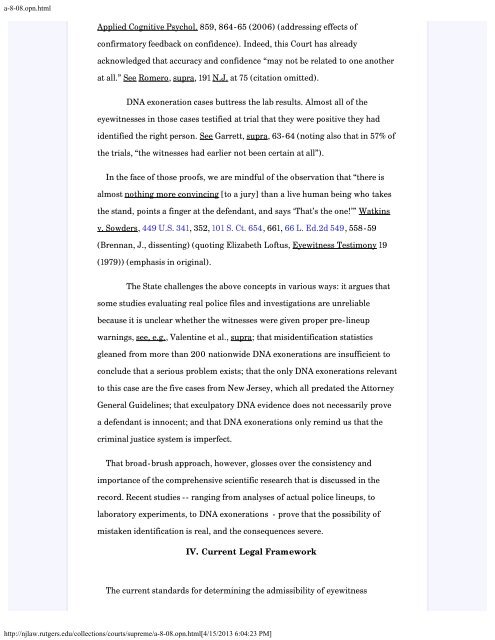State v. Henderson and the New Model Jury Charges - New Jersey ...
State v. Henderson and the New Model Jury Charges - New Jersey ...
State v. Henderson and the New Model Jury Charges - New Jersey ...
Create successful ePaper yourself
Turn your PDF publications into a flip-book with our unique Google optimized e-Paper software.
a-8-08.opn.html<br />
Applied Cognitive Psychol. 859, 864-65 (2006) (addressing effects of<br />
confirmatory feedback on confidence). Indeed, this Court has already<br />
acknowledged that accuracy <strong>and</strong> confidence “may not be related to one ano<strong>the</strong>r<br />
at all.” See Romero, supra, 191 N.J. at 75 (citation omitted).<br />
DNA exoneration cases buttress <strong>the</strong> lab results. Almost all of <strong>the</strong><br />
eyewitnesses in those cases testified at trial that <strong>the</strong>y were positive <strong>the</strong>y had<br />
identified <strong>the</strong> right person. See Garrett, supra, 63-64 (noting also that in 57% of<br />
<strong>the</strong> trials, “<strong>the</strong> witnesses had earlier not been certain at all”).<br />
In <strong>the</strong> face of those proofs, we are mindful of <strong>the</strong> observation that “<strong>the</strong>re is<br />
almost nothing more convincing [to a jury] than a live human being who takes<br />
<strong>the</strong> st<strong>and</strong>, points a finger at <strong>the</strong> defendant, <strong>and</strong> says ‘That’s <strong>the</strong> one!’” Watkins<br />
v. Sowders, 449 U.S. 341, 352, 101 S. Ct. 654, 661, 66 L. Ed.2d 549, 558-59<br />
(Brennan, J., dissenting) (quoting Elizabeth Loftus, Eyewitness Testimony 19<br />
(1979)) (emphasis in original).<br />
The <strong>State</strong> challenges <strong>the</strong> above concepts in various ways: it argues that<br />
some studies evaluating real police files <strong>and</strong> investigations are unreliable<br />
because it is unclear whe<strong>the</strong>r <strong>the</strong> witnesses were given proper pre-lineup<br />
warnings, see, e.g., Valentine et al., supra; that misidentification statistics<br />
gleaned from more than 200 nationwide DNA exonerations are insufficient to<br />
conclude that a serious problem exists; that <strong>the</strong> only DNA exonerations relevant<br />
to this case are <strong>the</strong> five cases from <strong>New</strong> <strong>Jersey</strong>, which all predated <strong>the</strong> Attorney<br />
General Guidelines; that exculpatory DNA evidence does not necessarily prove<br />
a defendant is innocent; <strong>and</strong> that DNA exonerations only remind us that <strong>the</strong><br />
criminal justice system is imperfect.<br />
That broad-brush approach, however, glosses over <strong>the</strong> consistency <strong>and</strong><br />
importance of <strong>the</strong> comprehensive scientific research that is discussed in <strong>the</strong><br />
record. Recent studies -- ranging from analyses of actual police lineups, to<br />
laboratory experiments, to DNA exonerations - prove that <strong>the</strong> possibility of<br />
mistaken identification is real, <strong>and</strong> <strong>the</strong> consequences severe.<br />
IV. Current Legal Framework<br />
The current st<strong>and</strong>ards for determining <strong>the</strong> admissibility of eyewitness<br />
http://njlaw.rutgers.edu/collections/courts/supreme/a-8-08.opn.html[4/15/2013 6:04:23 PM]
















